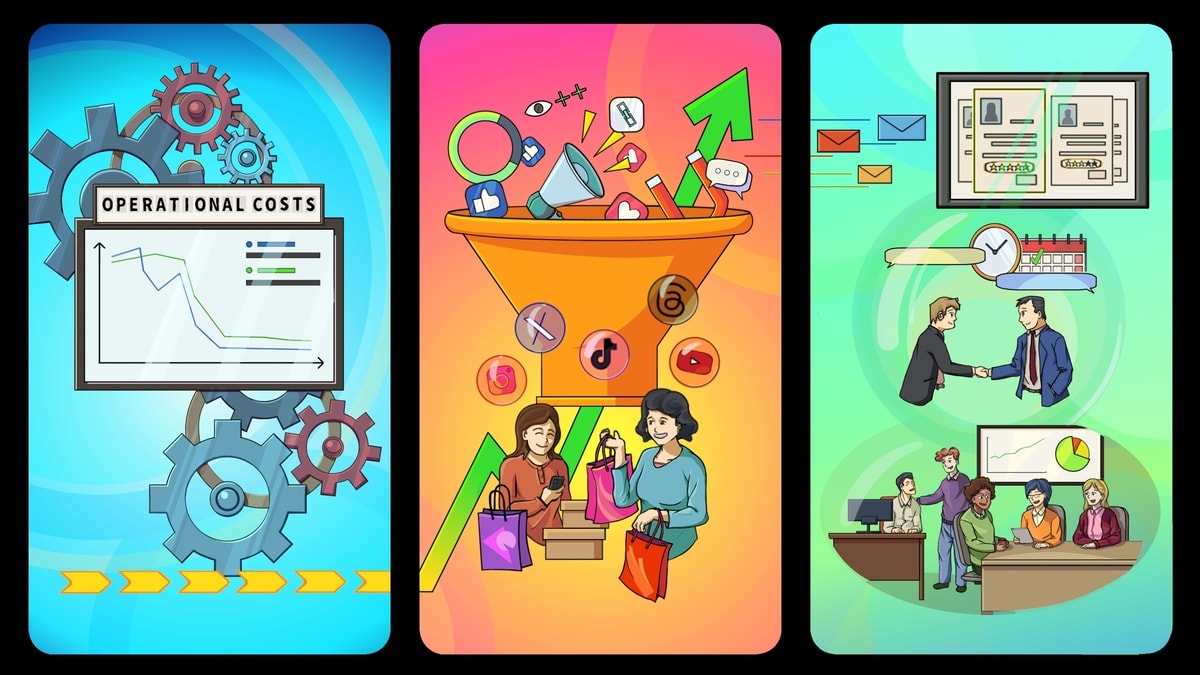Workflow Vs Business Process: (Key Differences)
Fast navigation
If you have a business, you should have a deep understanding of workflows and business processes.
The workflow automation market is set to reach $5 billion by 2024. On the other hand, the BPM sector forecasts an increase to $26.18 billion by 2028. These numbers support my suggestions above.
I often noticed, people tend to think workflows and business processes are the same.
But this article will clear out all your workflow vs business process confusion.

Defining the Basics
What is a Workflow?
Think of a workflow as your secret recipe for skyrocketing productivity. It's a series of steps and tasks, all linked together to get a specific job done.
Let's break it down: imagine you're making a coffee. First, you grind the beans, then you brew the coffee, and finally, you serve it.
In a business context, it's similar but more complex. Say, processing an invoice. You receive it, verify details, approve payment, and record the transaction.
What is Business Process?
A Business Process serves as a coordinating mechanism to ensure the harmonious operation of all components within an organization. It encompasses a series of activities designed to fulfill the objectives of a business efficiently.
Consider a retail store: from stocking shelves to customer service, each step is part of a larger business process. Each activity is interconnected, creating a seamless flow.
The impact? A whopping 21% of companies have slashed their costs by at least 10% with Business Processes. Imagine what you could do with those savings.
Differences Between Workflow and Business Process
Here are the nuanced differences between Workflow and Business Process through this detailed table, shedding light on their roles in organizational efficiency.
| Aspect | Workflow | Business Process |
|---|---|---|
| Nature | Specific sequence of steps (e.g., document approval process from drafting to final sign-off) | Encompasses multiple workflows, focusing on strategic outcomes (e.g., customer satisfaction and retention) |
| Focus | Task-focused, tactical. | Outcome-focused, strategic |
| Example | Responding to inquiries. | Overall customer satisfaction and retention. |
| Implementation Scope | Often confined to specific departments or tasks within an organization. | Cross-departmental, affecting various aspects of an organization's operations. |
| Technological Integration | Primarily focuses on automating tasks with specific tools and software. | Integrates various systems and technologies to enhance overall business performance and outcomes. |
| Potential for Innovation | Optimizes existing tasks for efficiency and speed. | Enables strategic innovation by reimagining and redesigning business operations for competitive advantage. |
Are Workflows and Business Process Related Anyhow?
Though they might seem worlds apart at first glance, workflows and business processes are actually best pals, working together to keep your business running smoothly.
Workflows are the nuts and bolts in the machinery of business processes. For instance, consider HR automation in recruitment. This workflow streamlines tasks like sorting resumes and scheduling interviews.
Now, 25% of organizations use this automation, greatly reducing time spent. This workflow is a cog in the larger business process of hiring the right talent.
They're separate, yet inseparably connected.
Practical Applications: Workflow and Business Process in Action
In the finance sector, the application of workflow and business process automation can dramatically reduce operational costs by up to 90%, streamlining transactions and minimizing errors.
Similarly, in marketing, the implementation of these processes significantly boosts lead generation and conversion rates, with 77% of marketers witnessing an uptick in conversions.
This illustrates the tangible impact of refining workflows and optimizing business processes across various industries. Through these examples, it becomes clear. Strategic automation in workflows and business processes does more than improve efficiency.
It transforms operations. This leads to better customer engagement and smarter use of resources. Each step in this evolution underscores the power of automation.
This allows businesses to not only achieve their current goals more efficiently but also to innovate and adapt to future challenges and opportunities, showcasing the dynamic potential of workflow and business process optimization in action.

Implementing Effective Workflows and Business Processes
Implementing effective workflows and business processes are like tuning your engine for the ultimate performance. And I'm here to hand you the tools.
Supatool can be your pit crew. Supatoola no-code dynamic workflows and forms make process automation a breeze. Think of it: AI-powered analytics for actionable insights, seamless integration with over 100 apps, and robust security protocols.
Bill Gates once said, "The first rule of any technology used in a business is that automation applied to an efficient operation will magnify the efficiency."
In fact, Businesses investing in BPM training see a 2.1 times higher ROI. So I’d suggest you try Supatool for your business.
Conclusion
So, we’ve journeyed together through the dynamic landscape of workflows and business processes. It's been quite the ride, hasn't it?
Let me recall again, workflows are your steps; business processes are the journey. They're distinct yet intertwined, each amplifying the other's impact.
Embracing tools like Supatool can revolutionize these aspects, driving efficiency and cost savings.
Interested in going further?